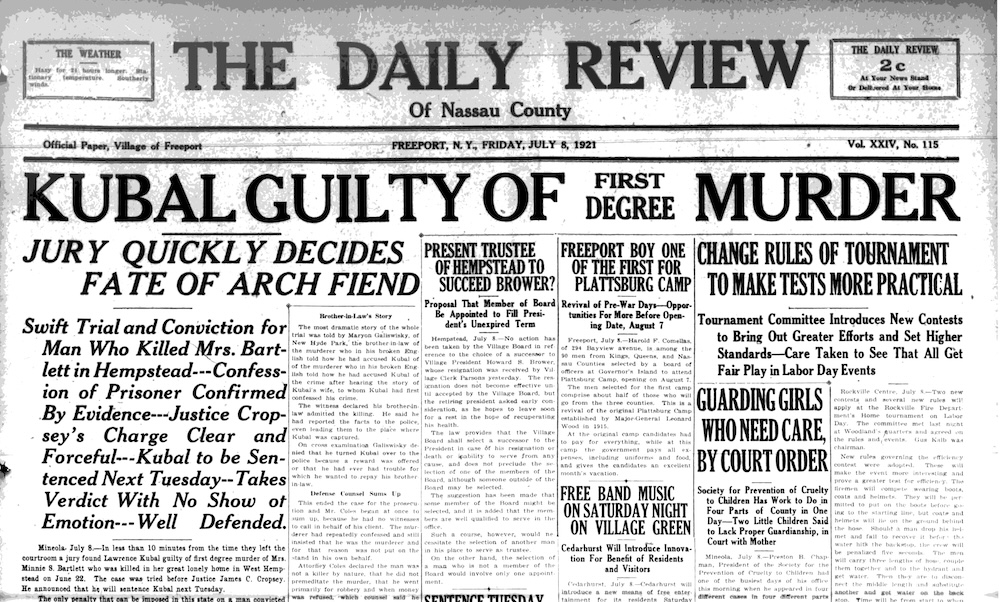Step into the shadows of Long Island’s past with our latest post on crime history. For better or worse, these gripping narratives of crime and consequence have etched themselves into our region’s story, shaping perceptions and igniting discussions about safety, justice, and community resilience. Join us as we delve into the cultural impact, investigative intricacies, and enduring echoes of these notorious incidents that have captivated true crime enthusiasts and prompted reflections on the human experience.
Joel Rifkin, serial killer caught because of a missing license plate
Joel Rifkin was born on January 20, 1959, in New York. He grew up in a troubled environment and struggled with social and emotional difficulties throughout his life.
Between 1989 and 1993, Rifkin committed a series of murders, primarily targeting sex workers in New York City and Long Island. He is known to have killed at least 17 women, although the exact number may be higher. Rifkin’s modus operandi involved picking up his victims, often sex workers, in his vehicle. He would then strangle them to death and dispose of their bodies in secluded areas, such as wooded areas, rivers, or remote locations.
Rifkin’s killing spree came to an end on June 28, 1993, when he was pulled over by law enforcement for a missing license plate. During the stop, officers discovered the body of one of Rifkin’s victims in his vehicle, leading to his arrest.Rifkin was charged with multiple counts of murder and ultimately convicted of nine murders in separate trials. He received a sentence of 203 years to life in prison without the possibility of parole.
The Joel Rifkin murders prompted extensive investigations into missing persons cases and highlighted issues related to the vulnerability of sex workers and the need for improved law enforcement responses to such crimes. The case received significant media coverage, both during Rifkin’s killing spree and throughout his trials and sentencing. It also inspired documentaries, books, and media discussions about serial killers and their motives.
Rifkin has been interviewed about two of his murders that remain nameless in a Cold Case Files episode titled “The Rifkin Murders”. In the episode, Rifkin says that he wants to help the families of his victims get closure and provides information that helps identify their victims.
Crazy Eddie, not only were his prices insane!
Eddie Antar, also known as “Crazy Eddie,” was a prominent businessman who operated the Crazy Eddie electronics retail chain in the 1970s and 1980s. Long Islanders knew his stores from their absolutely bonkers commercial.
Eddie Antar founded Crazy Eddie in 1971, starting as a small electronics store in Brooklyn, New York. The chain expanded rapidly, offering competitive prices and aggressive marketing tactics that made it a household name in the New York metropolitan area.
Behind the facade of Crazy Eddie’s success, Antar engaged in widespread fraudulent activities to inflate the company’s financial performance. These activities included falsifying inventory records, manipulating stock prices, and skimming cash from the business.
In the mid-1980s, the U.S. Securities and Exchange Commission (SEC) initiated an investigation into Crazy Eddie’s financial practices. The investigation uncovered the extent of Antar’s fraud, revealing millions of dollars in inflated profits and undisclosed liabilities.
In 1987, Antar fled to Israel to avoid prosecution. However, he was eventually extradited back to the United States in 1992. In 1993, Antar pleaded guilty to various charges, including securities fraud, racketeering, and conspiracy.
The downfall of Crazy Eddie had far-reaching consequences. The company declared bankruptcy in 1989, and its assets were liquidated. Eddie Antar’s fraudulent activities not only led to the collapse of Crazy Eddie but also affected investors, employees, and shareholders who suffered financial losses. Eddie Antar was sentenced to prison for his crimes. He served several years in prison and was ordered to pay restitution. After his release, Antar lived a relatively quiet life, staying out of the public eye. He died in 2016.
The Acid King of Northport
The “Acid King” case from Northport, also known as the Ricky Kasso case, is a notorious incident that occurred in 1984 and became associated with the so-called “Satanic Panic” of the 1980s.
Ricky Kasso, a teenager from Northport, became known as the “Acid King” due to his involvement with drugs, particularly LSD. Kasso was known for his rebellious behavior, drug use, and association with a group of friends who shared an interest in the occult and heavy metal music. Kasso dubbed himself “The Acid King” and allegedly dabbled in devil worship.
On June 16, 1984, Kasso and two friends, Jimmy Troiano and Albert Quinones, lured Gary Lauwers, another teenager from Northport, into the woods. There, Kasso accused Lauwers of owing him money for drugs. In a LSD-induced frenzy, Kasso brutally attacked Lauwers, ultimately killing him by stabbing him multiple times and gouging out his eyes. Kasso started bragging about the murder, sharing details with numerous classmates and even bringing some of them to see the body. An anonymous female eventually informed the police, leading to the discovery of Lauwers’ decomposed body in the woods on July 4, 1984.
The murder of Gary Lauwers gained widespread media coverage, especially due to the alleged involvement of Satanism and occult rituals. The case became part of the broader “Satanic Panic” phenomenon of the 1980s, where fears of Satanic cults and rituals were heightened in society. A famous picture of Kasso in newspapers showed him being led away in cuffs with long mangy hair wearing an AC/DC shirt feeding the frenzy over Satanic cult connection’s to heavy metal music.
Ricky Kasso was arrested and charged with murder. During his trial, Kasso’s defense argued that his drug use and mental state at the time of the murder should be considered.
The Acid King case had a lasting impact on popular culture, inspiring books, documentaries, and films that explored the events and their implications. It also contributed to the broader societal concerns and debates surrounding youth culture, drug use, mental health, and the influence of sensationalized media coverage. The murder inspired a heavily fictionalized telling of the events in a book titled Say You Love Satan published October 1, 1987 written by Dell Books.
Kasso never stood trial for the murder. He hanged himself with a bedsheet in his jail cell on July 7, 1984.
The Acid King case from Northport remains a dark and tragic chapter in Long Island’s history, highlighting the complexities of teenage life, drug abuse, mental health issues, and the cultural anxieties of the 1980s.
The DeFeo family murders and The Amityville Horror
In 1974, the DeFeo family murders shocked the small town of Amityville, New York. Ronald DeFeo Jr., known as Butch, murdered six members of his family in their home at 112 Ocean Avenue. The victims included his parents, Ronald DeFeo Sr. and Louise DeFeo, as well as his four siblings: Dawn, Allison, Marc, and John Matthew.
The murders took place on November 13, 1974, in the early hours of the morning. Ronald DeFeo Jr. used a .35 caliber lever-action Marlin 336C rifle to shoot each family member while they were sleeping. After the killings, he initially tried to create an alibi but later confessed to the crime.
The case gained national attention not only because of the brutality of the murders but also due to subsequent events. The Lutz family purchased the DeFeo home at a significantly reduced price in December 1975. They claimed to have experienced paranormal phenomena during their brief time living there, which led to the famous “Amityville Horror” story. This story was later popularized in a book by Jay Anson and adapted into several movies.
Ronald DeFeo Jr. was convicted of six counts of second-degree murder in 1975 and is serving a life sentence in prison. The case remains a prominent and controversial part of true crime history, with ongoing debates about the nature of the events surrounding the murders and the subsequent claims of supernatural activity.
The Suffolk County Sniper
In 1994, a sniper terrorized Long Island shooting through the windows of late-night businesses and killing a man and wounding a woman. The attacks occurred at night, and many residents were afraid to go out after dark. The Suffolk County police mounted the largest manhunt in the county’s history, increasing patrols along commercial strips. Peter Sylvester became the prime suspect after police linked him to the theft of three high-powered hunting rifles from a Suffolk County gun store.
According to a New York Times report fromt he time:
The first sniper incident in Suffolk, the fatal shooting in Commack of a diner patron, Steven Chaifetz, a 50-year-old lawyer, occurred on July 22, and was followed by shootings at a Burger King in Stony Brook, where Kathryn Spatafora, a 43-year-old waitress, was wounded, and at a gasoline station in East Commack, where Ali Gocmez, an attendant, was cut by flying glass.
Sylvester also tried to make it look like he was a random serial killer. Police described Sylvester as having a “Rambo complex”.
To catch the killer, detectives embarked on a mountain trek in the Catskills, searching for a tree with three bullets in it. Led by Detective Lieut. John W. Gierasch, they traversed five miles and successfully located the tree, despite skepticism from locals. Using chainsaws, they retrieved the tree’s midsection and transported it back to Long Island’s forensic laboratory.
This tree-related evidence led the police to confront Peter Sylvester, the alleged Suffolk County sniper, prompting a confession. Sylvester, a 24-year-old resident of Nesconset with a criminal history, had been a suspect since the sniper attacks began. Initial denials crumbled when the police presented evidence linking him to the stolen hunting rifle used in the attacks, aided by the bullets lodged in the tree.
Sylvester’s confession revealed his intent not only in the sniper attacks but also in planning a murder unrelated to his known victims. His disclosure of the rifle’s location and admission to other crimes, including robberies and rape, further solidified his culpability. The extensive investigation, including the mountain expedition for ballistic evidence, culminated in Sylvester’s confession and subsequent legal proceedings.
In 2002, Sylvester provided insights into the mindset of the sniper terrorizing Maryland, Virginia, and Washington, D.C. Sylvester, serving a lengthy sentence for a similar shooting spree in 1994, predicted the sniper would strike again, emphasizing the challenge and notoriety the sniper seeks. He suggested the sniper enjoys manipulating law enforcement and the media, possibly dropping clues and portraying himself as a mystical figure.
Sylvester dismissed the idea of the sniper being affiliated with terrorist networks like al Qaeda and agreed with reports about the likely profile of the sniper. He emphasized the sniper’s interest in news coverage and highlighted inaccuracies in media reports during his own spree. Sylvester recommended increased surveillance and urged the sniper to stop, warning of the severe consequences awaiting him if caught.
Want to read more about true crimes on Long Island? We recommend this book, “Historic Crimes of Long Island: Misdeeds from the 1600s to the 1950s (True Crime)”
Photo by cottonbro studio.




